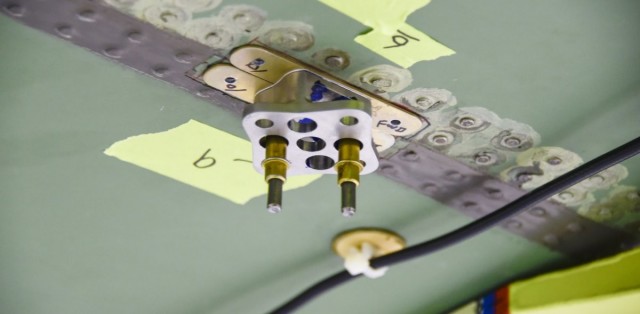The Northrop Grumman universal payload adapter attaches to the underside of the RQ-4 Global Hawk.
Northrop Grumman has started demonstrating the capability of the unmanned RQ-4B Global Hawk to carry new sensors, including sensors carried on the venerable U-2 Dragon Lady high-altitude reconnaissance aircraft, using a company-developed universal payload adapter. Supplementing the types of sensors the Global Hawk carries is part of a series of improvements the company is making to the aircraft to convince the U.S. Air Force of its utility as a U-2 replacement.
Under a cooperative research and development agreement (CRADA) with the Air Force, Northrop Grumman began flight tests of a representative “mass simulator” of the UTCAerospace Systems SYERS-2 multispectral imaging sensor in December, flying it most recently on January 14. The company expects to receive an operational sensor from the service next month that it will test and fly on the RQ-4B. The purpose of the demonstration is “to validate the ability of Global Hawk to seamlessly integrate into theUSAF tasking, collection, processing, exploitation and dissemination architecture,” Northrop Grumman said.
By the end of the summer, the company plans to begin testing a second U-2 legacy sensor, the UTC optical bar camera (OBC) on the Global Hawk. The integration and testing of the two sensors is a risk reduction exercise that will lead to testing the newUTC Aerospace MS-177 multispectral sensor, which Northrop Grumman plans to test in flight in early 2017.
“Global Hawk is on contract to be the first ISR (intelligence, surveillance and reconnaissance) system to operationalize the MS-177,” the company said in response to an AIN inquiry. “The open system architecture developed by Northrop Grumman and integrated on the Global Hawk for SYERS and OBC has paved the way for other payload integration efforts such as MS-177.”
In 2012, the Air Force sought to terminate the Global Hawk Block 30 program in favor of retaining the 60-year-old U-2. Subsequently, the service reversed course and awarded Northrop Grumman a $240 million contract in 2014 to build three additional Block 30 Global Hawks with integrated sensor and signals intelligence payloads, increasing the Block 30 fleet to 21 aircraft. There are also 11 wide-area surveillance Block 40 Global Hawks and four battle-area communication node (BACN) aircraft.
Last March, Northrop Grumman announced that it had driven down the cost per flight hour of the Global Hawk in 2014 to “half the cost of the manned alternative.” In November, the company announced plans to equip the aircraft with the Garmin GSX 70 weather radar beginning this spring.
The U-2 is now scheduled for retirement beginning in 2019. However, manufacturer Lockheed Martin is developing an open-mission system that would give the aircraft “plug and play” functionality for new sensors. “Don’t be surprised if 2019 comes and goes, and we’re still flying,” Orlando Carvalho, Lockheed Martin executive vice president for aeronautics, told AIN in September.
Northrop Grumman’s latest flight test of the SYERS-2 representative sensor coincided with a visit by reporters to the company’s Palmdale, Calif., manufacturing facility. During the visit, Mick Jaggers, the company’s Global Hawk program manager, displayed the universal payload adapter, a fitting that attaches to the underside of the Global Hawk fuselage to connect new sensors.
Source: AIN Online

